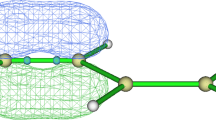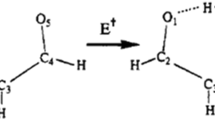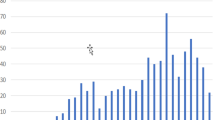Summary
Anab initio study of the ground and the first singlet excited states of acetaldehyde has been performed to analyze the molecular properties as a function of the methyl torsion and the aldehydic hydrogen wagging angles. The structural characteristics and the conformational behaviour in both electronic states have been determined. The important structural changes between the two states have been analyzed by a decomposition of the total energy into its components. It was found that the methyl torsion barriers arise mainly from attractive interactions. Evidence is presented which shows that these barriers arise from in-plane and out-of-plane hyperconjugative effects involving the oxygen atom. It is also shown that the pyramidalization experienced by the carbonyl carbon in the first singlet excited state has two sources, namely, a decrease in the electronic repulsion and an increase in the electron-nucleus attraction.
Similar content being viewed by others
References
Clouthier DJ, Moule DC (1989) Periodic Group Relationships in the Spectroscopy of the Carbonyls, Ketenes and Nitriles: The Effect of Substitution by Sulfur, Selenium, and Phosphorus. In: Dewar MJS, Dunitz JD, Hafner K, Heilbronner E, Ito S, Lehn J-M, Niedenzu K, Raymond KN, Rees CW, Vögtle F (eds) Topics in Current Chemistry, vol 150, Springer, Berlin, pp 167–247
Noble M, Lee EKC (1984) J Chem Phys 81:1632
Del Bene JE, Worth GT, Marchese FT, Conrad ME (1975) Theor Chim Acta 36:195
Bernardi F, Robb MA, Tonachini G (1979) Chem Phys Lett 66:195
Wiberg KB, Walters V, Colson SD (1984) J Phys Chem 88:4723
Wiberg KB, Martin E (1985) J Am Chem Soc 107:5035
Ozkabak AG, Goodman L (1992) J Chem Phys 96:5958
Crighton JS, Bell S (1985) J Mol Spectrosc 112:285
Baba M, Nagashima U, Hanazaki I (1985) J Chem Phys 83:3514
Kilb RW, Lin CC, Wilson Jr EB (1957) J Chem Phys 26:1695
Baba M, Hanazaki I, Nagashima U (1985) J Chem Phys 82:3938
Fink WH, Allen LC (1967) J Chem Phys 46:2276
Jorgensen WL, Allen LC (1970) Chem Phys Lett 7:483; Jorgensen WL, Allen LC (1971) J Am Chem Soc 93:567
Liberles A, O'Leary B, Eilers JE, Whitman DR (1972) J Am Chem Soc 94:6894
Moule DC, Ng KHK (1985) Can J Chem 63:1378
Walsh AD (1953) J Chem Soc 2036
Dupuis M, Spangler D, Wendoloski JJ (1980) in: National Resource for Computations in Chemistry, Software Catalog. University of California. Berkeley, CA. Program QG01; Schmidt MW, Boatz JA, Baldridge KK, Koseki S, Gordon MS, Elbert ST, Lam B (1987) QCPE Bull 7:115; Schmidt MW, Baldridge KK, Boatz JA, Jensen JH, Koseki S, Gordon MS, Nguyen KA, Windus TL, Elbert ST (1990) QCPE Bull 10:52
Hariharan PC, Pople JA (1973) Theor Chim Acta 28:213
Smeyers YG, Niño A, Bellido MN (1988) Theor Chim Acta 74:259
Broyden CG (1970) J Inst Maths Appl 6:76; Fletcher R (1970) Comp J 13:317; Goldfard D (1970) Math Comp 24:23; Shanno DF (1970) Math Comp 24:647
Nösberger P, Bauder A, Günthard HH (1973) Chem Phys 1:418; Harmony MD, Laurie VW, Kuczkowski RL, Schwendeman RH, Ramsay DA, Lobas FJ, Lafferty WJ, Maki AG (1979) J Phys Chem Ref Data 8:619
McKean DC (1978) Chem Soc Rev 7:399
Pople JA, Gordon M (1967) J Am Chem Soc 89:4253
Kleiner I, Hougen JT, Suenram RD, Lovas FJ, Godefroid M (1991) J Mol Spectrosc 148:38; Kleiner I, Hougen JT, Suenram RD, Lovas FJ, Godefroid M (1992) J Mol Spectrosc 153:578
Allen LC (1968) Chem Phys Lett 2:597
Neumann D, Moskowitz JW (1968) J Chem Phys 49:2056
Hellmann H (1937) in: Einführung in der Quantemchemie, Deuticke, Leipzig, p 285; Feynman RP (1939) Phys Rev 56:340
Mulliken RS, Rieke CA, Brown WG (1941) J Am Chem Soc 63:41
Dill JD, Schleyer PR, Pople JA (1976) J Am Chem Soc 98:1663
Author information
Authors and Affiliations
Rights and permissions
About this article
Cite this article
Muñoz-Caro, C., Niño, A. & Moule, D.C. On the origin of the barriers and the structures of acetaldehyde in its ground and first singlet excited state. Theoret. Chim. Acta 88, 299–310 (1994). https://doi.org/10.1007/BF01113453
Received:
Accepted:
Issue Date:
DOI: https://doi.org/10.1007/BF01113453




